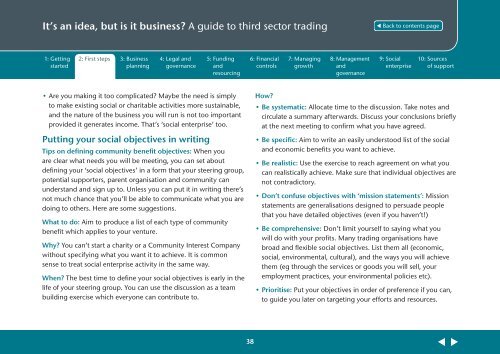A guide to third sector trading - WCVA
A guide to third sector trading - WCVA
A guide to third sector trading - WCVA
Create successful ePaper yourself
Turn your PDF publications into a flip-book with our unique Google optimized e-Paper software.
It’s an idea, but is it business? A <strong>guide</strong> <strong>to</strong> <strong>third</strong> sec<strong>to</strong>r <strong>trading</strong><br />
1: Getting<br />
started<br />
2: First steps 3: Business<br />
planning<br />
4: Legal and<br />
governance<br />
5: Funding<br />
and<br />
resourcing<br />
6: Financial<br />
controls<br />
7: Managing<br />
growth<br />
8: Management<br />
and<br />
governance<br />
9: Social<br />
enterprise<br />
10: Sources<br />
of support<br />
• Are you making it <strong>to</strong>o complicated? Maybe the need is simply<br />
<strong>to</strong> make existing social or charitable activities more sustainable,<br />
and the nature of the business you will run is not <strong>to</strong>o important<br />
provided it generates income. That’s ‘social enterprise’ <strong>to</strong>o.<br />
Putting your social objectives in writing<br />
Tips on defining community benefit objectives: When you<br />
are clear what needs you will be meeting, you can set about<br />
defining your ‘social objectives’ in a form that your steering group,<br />
potential supporters, parent organisation and community can<br />
understand and sign up <strong>to</strong>. Unless you can put it in writing there’s<br />
not much chance that you’ll be able <strong>to</strong> communicate what you are<br />
doing <strong>to</strong> others. Here are some suggestions.<br />
What <strong>to</strong> do: Aim <strong>to</strong> produce a list of each type of community<br />
benefit which applies <strong>to</strong> your venture.<br />
Why? You can’t start a charity or a Community Interest Company<br />
without specifying what you want it <strong>to</strong> achieve. It is common<br />
sense <strong>to</strong> treat social enterprise activity in the same way.<br />
When? The best time <strong>to</strong> define your social objectives is early in the<br />
life of your steering group. You can use the discussion as a team<br />
building exercise which everyone can contribute <strong>to</strong>.<br />
How?<br />
• Be systematic: Allocate time <strong>to</strong> the discussion. Take notes and<br />
circulate a summary afterwards. Discuss your conclusions briefly<br />
at the next meeting <strong>to</strong> confirm what you have agreed.<br />
• Be specific: Aim <strong>to</strong> write an easily unders<strong>to</strong>od list of the social<br />
and economic benefits you want <strong>to</strong> achieve.<br />
• Be realistic: Use the exercise <strong>to</strong> reach agreement on what you<br />
can realistically achieve. Make sure that individual objectives are<br />
not contradic<strong>to</strong>ry.<br />
• Don’t confuse objectives with ‘mission statements’: Mission<br />
statements are generalisations designed <strong>to</strong> persuade people<br />
that you have detailed objectives (even if you haven’t!)<br />
• Be comprehensive: Don’t limit yourself <strong>to</strong> saying what you<br />
will do with your profits. Many <strong>trading</strong> organisations have<br />
broad and flexible social objectives. List them all (economic,<br />
social, environmental, cultural), and the ways you will achieve<br />
them (eg through the services or goods you will sell, your<br />
employment practices, your environmental policies etc).<br />
• Prioritise: Put your objectives in order of preference if you can,<br />
<strong>to</strong> <strong>guide</strong> you later on targeting your efforts and resources.<br />
38












